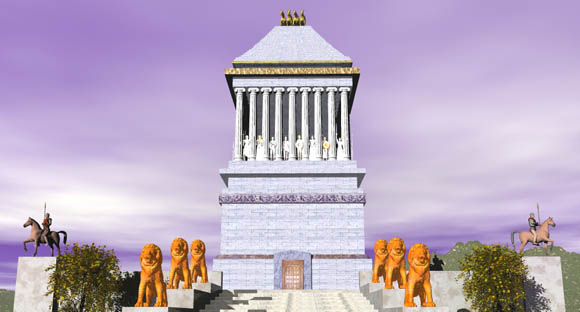I already posted the second one but now they are in sequence
Here is the new one, which should be seen first....
http://youtu.be/_ZWomUN0M5g
And then the other one...
http://youtu.be/trAqkTiqj_k
By the way, in the picture of Bowling Green you will notice the one old skyscraper with the fancy top...
An architect friend informs me that the top is based on the Mausoleum of Halicarnassus...
This from a site on the internet called " The Museum of Unnatural History-- Seven Wonders of the Ancient World"
The Mausoleum at Halicarnassus
 |
In 377 B.C., the city of Halicarnassus was the capitol
of a small kingdom along the Mediterranean coast of Asia Minor.
It was in that year the ruler of this land, Hecatomnus of Mylasa,
died and left control of the kingdom to his son, Mausolus. Hecatomnus,
a local satrap to the Persians, had been ambitious and had taken
control of several of the neighboring cities and districts. Then
Mausolus during his reign extended the territory even further
so that it eventually included most of southwestern Asia Minor.
Mausolus, with his queen Artemisia, ruled over Halicarnassus
and the surrounding territory for 24 years. Though he was descended
from the local people, Mausolus spoke Greek and admired the Greek
way of life and government. He founded many cities of Greek design
along the coast and encouraged Greek democratic traditions.
Mausolus's
Death
|
Seven
Quick Facts
|
| Location: Halicarnassus (Modern Bodrum, Turkey) |
| Built: Around 350 B.C. |
| Function: Tomb for the City King, Mausolus |
| Destroyed: Damaged by earthquakes in 13th century A.D. . Final destruction by Crusaders in 1522 A.D. |
| Size: 140 feet (43m) high. |
| Made of: White Marble |
| Other: Built in a mixture of Egyptian, Greek and Lycian styles |
Then in 353 B.C. Mausolus died, leaving his queen
Artemisia, who was also his sister, broken-hearted (It was the
custom in Caria for rulers to marry their own sisters). As a tribute
to him, she decided to build him the most splendid tomb in the
known world. It became a structure so famous that Mausolus's name
is now associated with all stately tombs throughout the world
through the word mausoleum. The building, rich with statuary
and carvings in relief, was so beautiful and unique it became
one of the Seven Wonders of the Ancient
World.
Artemisia decided that no expense was to be spared
in the building of the tomb. She sent messengers to Greece to
find the most talented artists of the time. These included architects
Satyros and Pytheos who designed the overall shape of the tomb.
Other famous sculptors invited to contribute to the project were
Bryaxis, Leochares, Timotheus and Scopas of Paros (who was responsible
for rebuilding the Temple of Artemis at Ephesus, another of the
wonders). According to the historian Pliny Bryaxis, Leochares,
Timotheus and Scopas each took one side of the tomb to decorate.
Joining these sculptors were also hundreds of other workmen and
craftsmen. Together they finished the building in the styles of
three different cultures: Egyptian, Greek and Lycian.
The tomb was erected on a hill overlooking the city.
The whole structure sat in the center of an enclosed courtyard
on a stone platform. A staircase, flanked by stone lions, led
to the top of this platform. Along the outer wall of the courtyard
were many statues depicting gods and goddesses. At each corner
stone warriors, mounted on horseback, guarded the tomb.

A
map of the city of Halicarnassus drawn by the archeologist
J D Barbié du Bocage in 1802 showing the tomb in the middle
of the city.
|
At the center of the platform was the tomb itself.
Made mostly of marble, the structure rose as a square, tapering
block to about one-third of the Mausoleum's 140 foot height. This
section was covered with relief sculpture showing action scenes
from Greek myth/history. One part showed the battle of the Centaurs
with the Lapiths. Another depicted Greeks in combat with the Amazons,
a race of warrior women. On top of this section of the tomb thirty-six
slim columns rose for another third of the height. Standing in
between each column was another statue. Behind the columns was
a solid block that carried the weight of the tomb's massive roof.
The roof, which comprised most of the final third
of the height, was in the form of a stepped pyramid with 24 levels.
Perched on top was the tomb's penultimate work of sculpture craved
by Pytheos: Four massive horses pulling a chariot in which images
of Mausolus and Artemisia rode.
The
City in Crisis
Soon after construction of the tomb started Artemisia
found herself in a crisis. Rhodes, an island in the Aegean Sea
between Greece and Asia Minor, had been conquered by Mausolus.
When the Rhodians heard of his death, they rebelled and sent a
fleet of ships to capture the city of Halicarnassus. Knowing that
the Rhodian fleet was on the way, Artemisa hid her own ships at
a secret location at the east end of the city's harbor. After
troops from the Rhodian fleet disembarked to attack, Artemisia's
fleet made a surprise raid, captured the Rhodian fleet, and towed
it out to sea.

No comments:
Post a Comment
Please leave a comment-- or suggestions, particularly of topics and places you'd like to see covered